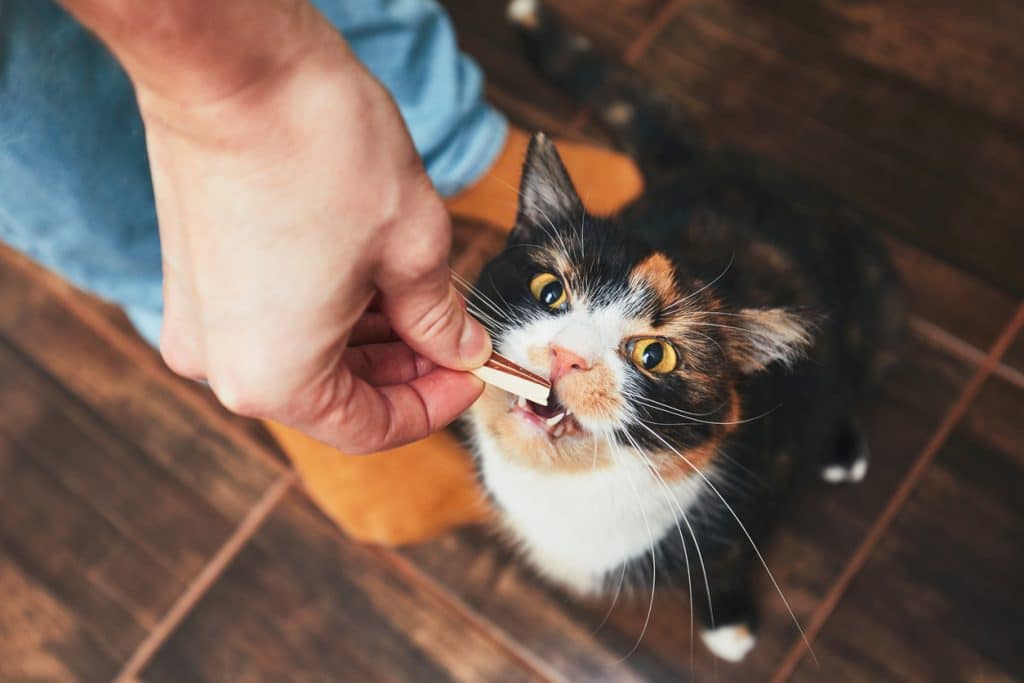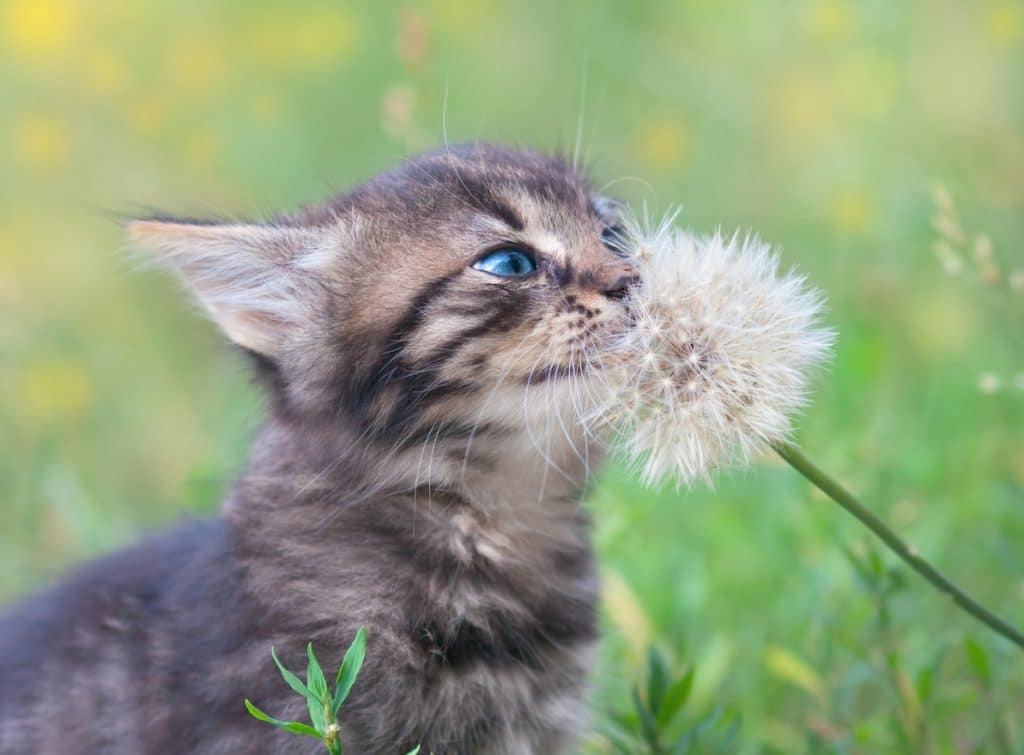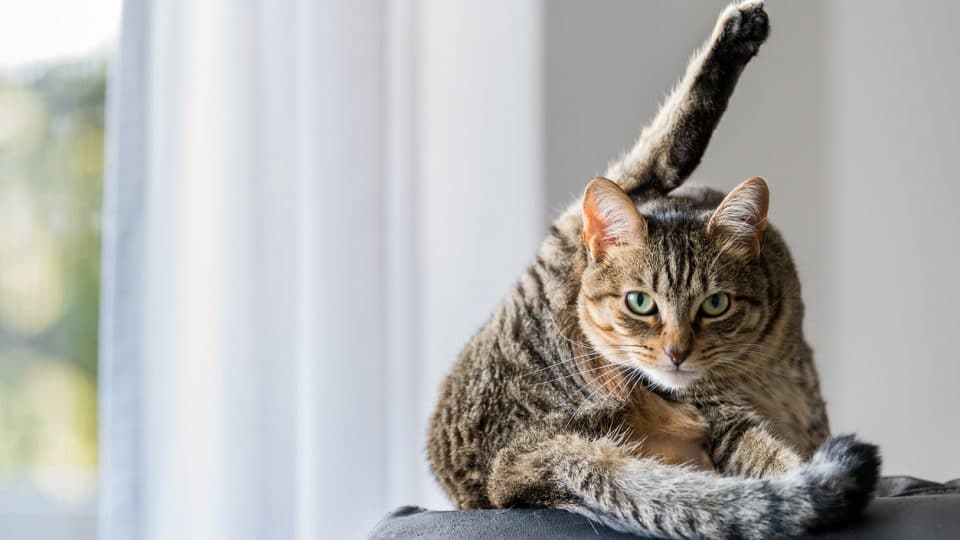If you can’t bear the thought of itchy eyes, a running nose, and sneezing at the mere sight of a furry friend, I’m right there with you. Unfortunately, being allergic to pets isn’t a rare occurrence, with as many as three in 10 people experiencing allergies to pets—and cats are the leading offender. If you suffer from allergies, know that you’re not alone; the furry friend causing your sneezes might suffer from allergies too. In fact, allergies in cats can look, and feel, a lot like they do in humans.
Cats are commonly allergic to fleas and could have food, contact, or inhalant allergies, too. Plus, many share our misery of seasonal allergies. Luckily for cats, there’s an allergen-free light at the end of the tunnel. Here are the most common allergies in cats and the most effective treatments and prevention.
Most Common Allergies in Cats
If your cat is itching more than usual, there’s a good chance she’s experiencing feline allergies. Feline atopic dermatitis is the fancy word vets use to describe an allergic reaction affecting the skin and causing pruritis—aka excessive itchiness. You might also notice skin lesions or redness of the skin below their fur. Environmental irritants are the most common allergic reaction in cats, with flea allergies being the leading culprit. Seasonal allergies to stuff like pollen and dust aren’t far behind.
Your cat will appreciate relief from allergies. Your vet will also go over your cat’s history and lifestyle and might run a few lab tests. To help spot the signs of common feline allergies, here’s an overview of allergies in cats.

iStock/Chalabala
Flea Allergies in Cats
The most common allergy among cats is caused by fleas. Here’s what you should know.
Definition: Allergies to fleas are rooted in the reaction to a flea’s saliva, Dr. Gary Richter, Rover’s resident vet on The Dog People Panel says. When a flea bites its host, it injects a slew of histamine-like compounds that cause a reaction in the immune system of pets and humans.
Symptoms: Itching is a tell-tale sign your cat has been bitten by fleas and reacting to the allergens in their saliva. Reactions could be immediate or delayed following a bite. Signs your cat is experiencing a reaction to fleas include:
- Scratching their head and ears
- Chewing and biting themselves
- Excessive licking, especially around the legs
- Red, irritated skin
- Patches of fur loss
Cats with fleas will also have little specks of dark flea dirt left behind from the fleas. Kittens can experience a loss of blood which can cause flea anaemia and severe health impacts. All cats can contract diseases and parasites like tapeworms from the bite of a flea.
Treatment: Flea prevention is the number one way to prevent allergies to fleas, Dr. Richter says. “This is a standard veterinary recommendation, even if you rarely see a flea.” If your home already has a population of fleas, a deep clean alongside monthly preventative flea treatments should do the trick.
To provide your cat with relief from fleas in the meantime, Dr. Richter says you can try a soothing bath or wipes.
Food Allergies in Cats
“True food allergies are relatively uncommon in pets,” Dr. Richter explains. “The majority of allergies come from more common environmental sources such as fleas, dust, pollen, or mould.” Here’s how you can tell if your cat has food allergies versus food sensitivities.
Definition: According to Dr. Richter, about 30% of allergies in pets are due to a food allergy. Typically, a cat is allergic to a particular protein found in their food. A food allergy is defined as a reaction to the immune system while a food sensitivity (a reaction to gluten or certain carbohydrates, for example) will cause a reaction to the digestive system only.
Symptoms: Food allergies in cats might be spotted by reactions to the skin, upper respiratory system, and the digestive system including:
- Red, itchy skin
- Flaky or greasy skin
- Poor coat condition
- Vomiting
- Diarrhoea
- Gas
- Weight loss
- Conjunctivitis
- Difficulty breathing
Narrowing down a food allergy can be tough detective work and is best done alongside your vet, says Dog People Panelist Dr. Rebecca Greenstein. “If you’re noticing that someone is showing unusual symptoms, skin issues, or tummy upset issues that happen within several weeks of a recent diet change or the introduction of a new treat, it certainly would be suggestive of an underlying dietary allergy.”
Treatment: Dr. Greenstein says the first step in treating food allergies is to talk with your vet. Because food allergies can be hard to pinpoint, many owners find themselves in cycles of switching foods with no relief. Kittens with food allergies might grow out of them while other cats will need a special diet. When speaking with your vet, Dr. Richter says to ask if switching from canned or dry food to a fresh (raw or freeze-dried) whole-food diet could solve your cat’s dietary issues.
Inhalant Allergies in Cats
Inhalant allergies can be common among indoor and outdoor cats. Here’s how to recognise inhalant allergies from other types of feline allergies.
Definition: Inhalant allergies in cats are brought on by airborne irritants. They can be caused by outdoor or indoor irritants and can persist all year round or be seasonal. Airborne irritants known to cause allergies in cats include pollen, dust, mould, volatile organic compounds (like perfume), and smoke.
Symptoms: The symptoms of inhalant allergies in cats tend to affect the upper respiratory system more than food, flea, or contact allergens. Here’s what to look out for:
- Red, watery eyes
- Itchy eyes and pawing at the face and eyes
- Nasal discharge
- Coughing, sneezing, or wheezing
- Rash or itchy skin
Treatment: If your cat is showing symptoms of inhalant allergies, there are a few changes you can make a home:
- Skip dust-producing litter and reach for dust-free litter
- Bin harsh chemical cleaning products and replace them with pet-safe products.
- Wipe down cats after every outdoor adventure.
- Avoid the use of incense, candles, perfumes, and essential oils.
If your cat is still suffering from allergies with at-home changes, talk to your vet about anti-allergy medications. It’s never safe to give your cat human medications or eye drops without direction from your vet.

iStock/Angela Kotsell
Contact Allergies on Cats
Contact allergies are the least common type of allergies in cats. Here’s how to tell if your cat has contact allergies and how to provide relief.
Definition: A contact allergy is when the immune system reacts to skin contact with an irritant.
Symptoms: Skin allergies in cats will typically have a localised reaction including:
- Itchiness
- Redness
- Rash or irritation
Treatment: Contact allergies could be caused by flea collars, a type of bedding, shampoos, or other substances with skin-irritating ingredients. Usually, removing or stopping the use of the irritant will prevent future allergic reactions, but it can be hard to pinpoint what is causing the reaction. To provide relief to a contact allergen, Dr. Richter says to try these at-home remedies:
- Use a hypoallergenic, gentle, or medicated shampoo
- Give skin-healthy supplements like omega-3s
- Apply a soothing, medicated spray
Do Cats Get Seasonal Allergies?
Yes, indoor and outdoor cats can suffer from seasonal allergies. Seasonal allergies in cats are similar to what their human companions may suffer from. This is because seasonal allergies in cats are triggered by the same irritants and bind to the same type of cells that trigger immune reactions in humans.
Like us, a common seasonal allergy for cats is pollen. Whether your cat is indoors or out, the microscopic particles can make their way into the home and trigger sneezing, itchy, red eyes, wheezing, and skin irritation. Other common seasonal allergies include dust and mould.

iStock/vvvita
Does My Cat Have Allergies or Asthma?
Asthma is more common in cats than dogs, Dr. Richter says. But the diagnosis of asthma in cats is relatively uncommon he adds. Young cats, Siamese cats, and Himalayan cats are most commonly diagnosed with feline asthma.
When our cats, or we, suffer from asthma, the tissue in the lungs becomes irritated. This causes shortness of breath and wheezing. The hallmark of asthma versus an allergy attack, Dr. Richter explains, is difficulty exhaling. In cats with asthma, the tissue in the lungs that is irritated and inflamed causes air to get trapped and makes it difficult to breathe out.
Asthma and allergies are different, but they are related. Allergies can trigger an asthma attack and exposure to allergens can make an asthma attack more severe. Research shows that having reactions to allergies can increase the risk of developing asthma, but just because your cat has allergies it doesn’t mean they’ll develop asthma.
Can You Prevent Cats From Getting Allergies?
You can’t prevent your cat from developing an allergic reaction to a food or airborne irritant. The good news is that you can provide your favourite feline with a home that promotes a healthy lifestyle—for you and for her.
Simple acts like choosing non-irritating cleaners and litters will feel good to your cat’s sensitive nose and reduce the risk of an allergy attack. In the spring when seasonal allergies are attacking us all, turn on the air purifier to help the whole clowder breathe easier.
Above all, listening to your cat’s body language and reacting to any changes in behaviour or digestive health will keep them happy and healthy.
Takeaway
Allergies can wreak havoc on humans and cats alike. If you think your cat is experiencing allergies, talk to your vet. They can help you find the underlying cause of itchiness, digestive upset, or wheezing. In some cases, your vet might recommend seeing a kitty allergist to help narrow down the culprit and find your cat relief.
Allergies can mirror other underlying conditions including autoimmune disorders, infections, or neurological disorders. So, it’s best to get to the root of discomfort sooner rather than later. When in doubt about changes in behaviour, recommended diet changes, or cat-safe anti-allergy medication, talk with your vet.



